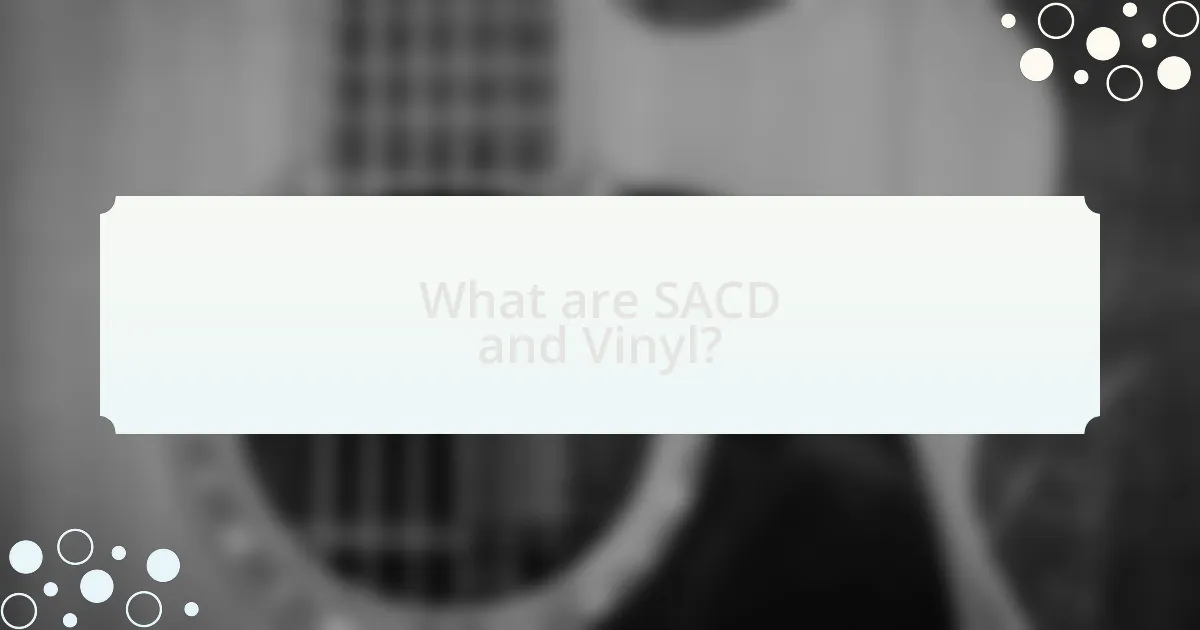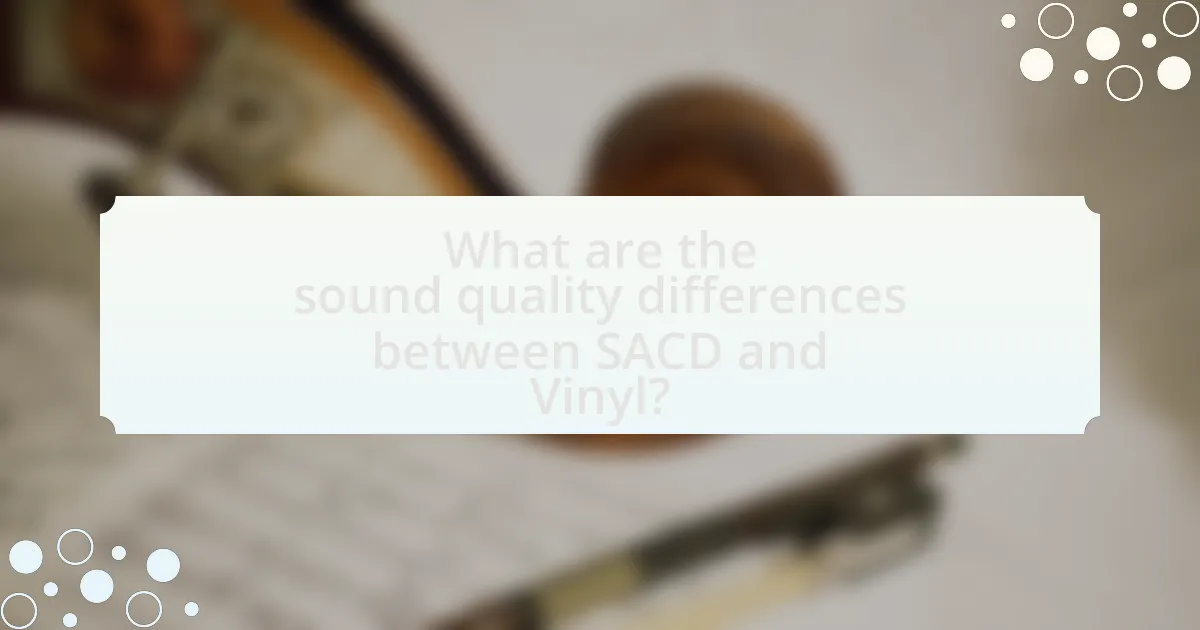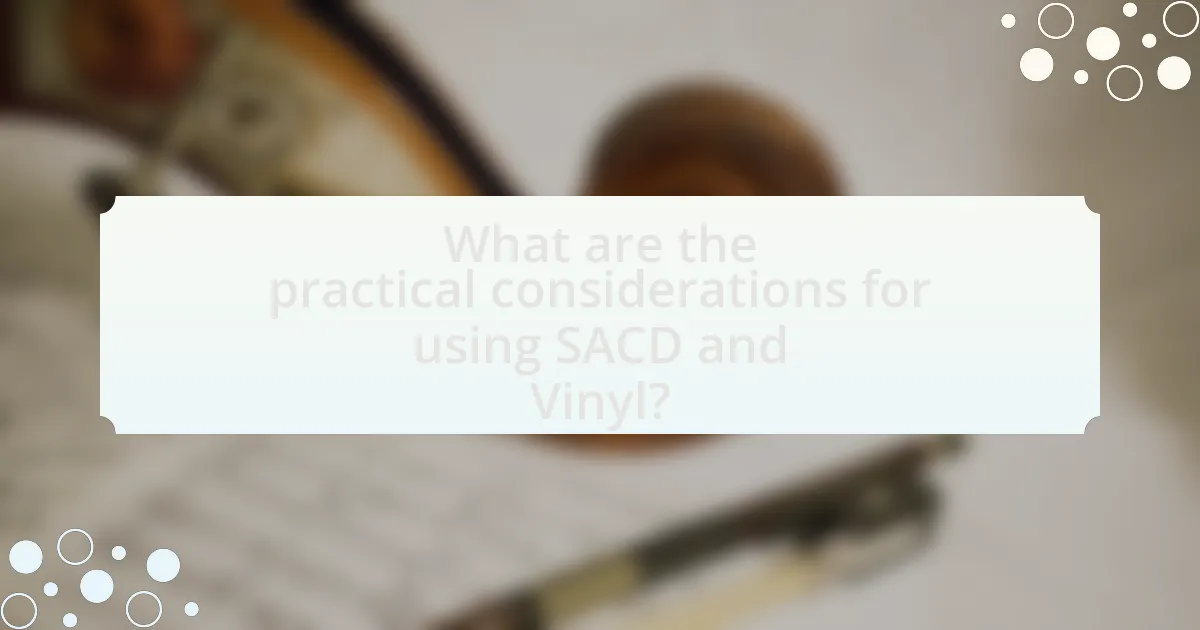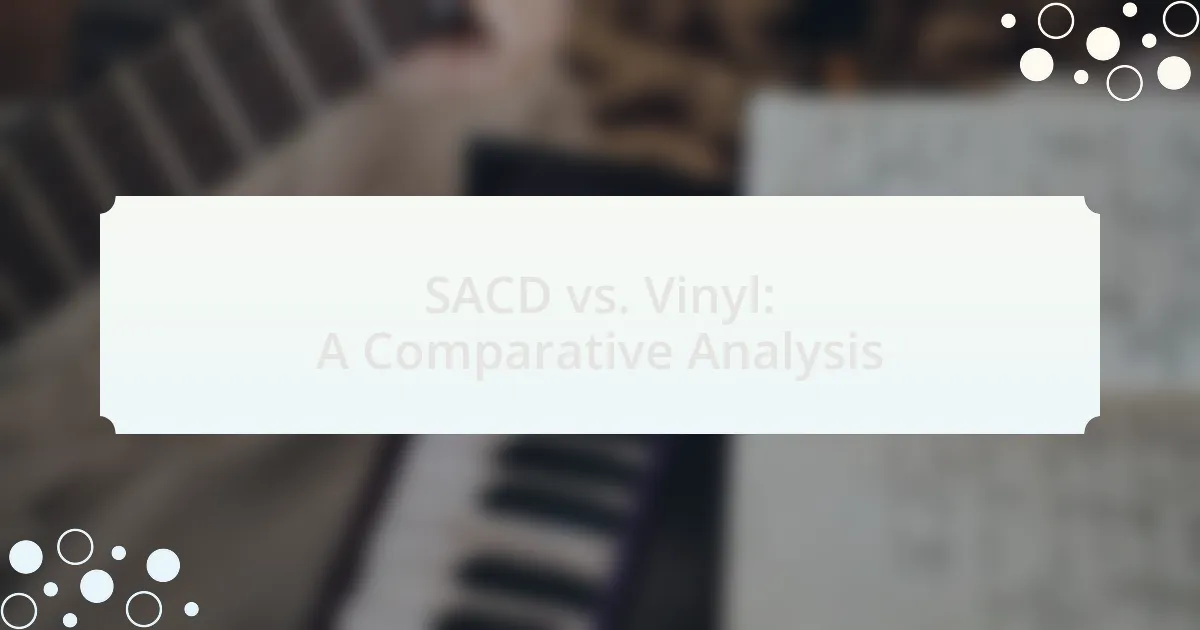SACD (Super Audio CD) and vinyl are two distinct audio formats that cater to different listening preferences and experiences. SACD, introduced in 1999, utilizes Direct Stream Digital (DSD) technology to deliver high-resolution, multi-channel audio, offering superior sound quality and dynamic range compared to traditional CDs and vinyl records. In contrast, vinyl records, which have been popular since the late 19th century, are celebrated for their warm, analog sound and tactile engagement, appealing to collectors and audiophiles alike. This article provides a comparative analysis of SACD and vinyl, examining their technological differences, sound quality, historical context, listener experiences, and practical considerations, including costs and storage requirements.
What are SACD and Vinyl?

SACD, or Super Audio CD, is a high-resolution audio format that offers superior sound quality compared to standard CDs by utilizing a different encoding method called Direct Stream Digital (DSD). Vinyl refers to a traditional analog format for music playback, where sound is etched into a disc made of polyvinyl chloride, commonly known as vinyl. SACD provides a multi-channel audio experience, while vinyl is celebrated for its warm sound and tactile experience. The SACD format was introduced in 1999 by Sony and Philips, while vinyl records have been in use since the late 19th century, with a resurgence in popularity in recent years due to their nostalgic appeal and perceived audio quality.
How do SACD and Vinyl differ in terms of technology?
SACD (Super Audio CD) and Vinyl differ significantly in technology, primarily in their format and playback methods. SACD utilizes a digital format that employs Direct Stream Digital (DSD) encoding, allowing for higher resolution audio compared to the analog format of Vinyl, which relies on grooves etched into a physical disc to reproduce sound. The DSD format in SACD can capture audio frequencies up to 100 kHz, while Vinyl typically reproduces frequencies up to around 20 kHz. This difference in encoding and playback technology results in SACD offering a broader dynamic range and lower distortion levels than Vinyl, which is subject to physical wear and environmental factors affecting sound quality.
What are the key features of SACD?
The key features of SACD (Super Audio CD) include high-resolution audio, multi-channel sound capabilities, and a hybrid disc format. SACD supports audio sampling rates up to 2.8224 MHz, which is significantly higher than standard CDs, allowing for greater detail and clarity in sound reproduction. Additionally, SACD can deliver multi-channel audio, providing an immersive listening experience through surround sound. The hybrid format allows SACDs to be played on standard CD players, making them accessible while still offering enhanced audio quality on compatible SACD players. These features collectively position SACD as a superior audio format compared to traditional CDs and even vinyl in terms of sound fidelity and versatility.
What are the key features of Vinyl?
Vinyl records are characterized by their analog sound quality, durability, and tactile experience. The analog format allows for a warm, rich sound that many audiophiles prefer, as it captures a broader frequency range compared to digital formats. Vinyl is also known for its physical durability; with proper care, records can last for decades without significant degradation in sound quality. Additionally, the large format of vinyl records provides an engaging visual and tactile experience, allowing listeners to appreciate album artwork and the act of handling the record itself. These features contribute to vinyl’s enduring popularity in the music industry.
What historical context surrounds SACD and Vinyl?
SACD (Super Audio CD) and vinyl records have distinct historical contexts that reflect the evolution of audio technology. Vinyl records emerged in the late 19th century, becoming the dominant format for music playback by the mid-20th century, with the 33 1/3 RPM LP introduced by Columbia Records in 1948, which allowed for longer playtime and better sound quality compared to earlier shellac records. In contrast, SACD was introduced in 1999 by Sony and Philips as a high-resolution audio format aimed at providing superior sound quality through multi-channel audio and higher sampling rates, targeting audiophiles and the home theater market. The introduction of SACD came during a period of declining CD sales and the rise of digital downloads, marking a shift in consumer preferences towards higher fidelity formats.
When was SACD introduced and what was its purpose?
SACD, or Super Audio CD, was introduced in 1999. Its primary purpose was to provide a higher quality audio format than standard CDs, utilizing a different encoding method called Direct Stream Digital (DSD) to deliver superior sound fidelity and a wider dynamic range. This format aimed to enhance the listening experience for audiophiles and music enthusiasts by offering multi-channel audio capabilities and improved sound reproduction.
When did Vinyl become popular and how has it evolved?
Vinyl became popular in the mid-20th century, particularly during the 1950s and 1960s, when it replaced shellac records as the primary medium for music distribution. The introduction of the 33 1/3 RPM long-playing (LP) record in 1948 by Columbia Records significantly contributed to its rise, allowing for longer playback times and better sound quality. Over the decades, vinyl has evolved through various phases, including a decline in the late 1980s with the advent of cassette tapes and CDs, followed by a resurgence in the 2000s driven by a renewed interest in analog sound and collectible formats. As of 2020, vinyl sales surpassed CD sales in the United States for the first time since the 1980s, highlighting its enduring appeal and cultural significance.
What are the primary uses of SACD and Vinyl?
The primary uses of SACD (Super Audio CD) and Vinyl are for high-fidelity music playback. SACD is utilized for its ability to deliver superior sound quality through its multi-channel audio capabilities and higher sampling rates, making it ideal for audiophiles seeking an immersive listening experience. Vinyl records, on the other hand, are favored for their warm sound and nostalgic appeal, often preferred by collectors and enthusiasts who appreciate the tactile experience of analog music. Both formats serve the purpose of providing enhanced audio experiences, with SACD focusing on digital high-resolution sound and Vinyl emphasizing analog warmth and character.
In what settings is SACD most commonly used?
SACD is most commonly used in high-fidelity audio settings, such as audiophile listening rooms, home theaters, and professional music studios. These environments prioritize sound quality and often feature high-end audio equipment capable of reproducing the superior audio resolution that SACD offers. The format’s ability to deliver multi-channel audio and high-resolution stereo sound makes it particularly appealing for music enthusiasts and professionals seeking an enhanced listening experience.
In what settings is Vinyl most commonly used?
Vinyl is most commonly used in settings such as home audio systems, record stores, and live music venues. In home audio systems, vinyl records are favored for their analog sound quality, which many audiophiles believe provides a warmer and richer listening experience compared to digital formats. Record stores often feature vinyl prominently, catering to collectors and enthusiasts who appreciate the tangible nature of records and the large album artwork. Additionally, live music venues may sell vinyl records of performing artists, allowing fans to purchase physical copies of their music. These settings highlight vinyl’s enduring popularity and cultural significance in the music industry.
What are the sound quality differences between SACD and Vinyl?

SACD generally offers superior sound quality compared to vinyl due to its higher resolution and wider dynamic range. SACD, or Super Audio CD, utilizes a DSD (Direct Stream Digital) format that captures audio at a sampling rate of 2.8224 MHz, significantly higher than the 44.1 kHz of standard CDs and the analog limitations of vinyl records. This higher resolution allows for more accurate reproduction of sound, resulting in clearer highs and deeper lows.
In contrast, vinyl records, while praised for their warmth and character, are subject to physical limitations such as surface noise, distortion, and wear over time, which can affect sound quality. Additionally, the dynamic range of vinyl is typically around 70 dB, while SACD can exceed 120 dB, allowing for a more nuanced listening experience.
These technical specifications demonstrate that SACD provides a more precise and detailed audio experience compared to vinyl, which, despite its unique qualities, cannot match the clarity and fidelity of SACD recordings.
How does the audio fidelity of SACD compare to Vinyl?
The audio fidelity of SACD is generally superior to that of vinyl. SACD, or Super Audio CD, utilizes a higher sampling rate and bit depth, typically 2.8 MHz DSD (Direct Stream Digital), which allows for a broader frequency response and dynamic range compared to vinyl records, which are limited by their analog nature and typically have a frequency response up to 20 kHz. Additionally, SACD’s digital format minimizes distortion and noise, providing clearer sound reproduction. Studies have shown that listeners often perceive SACD as having more detail and clarity than vinyl, particularly in complex musical passages.
What factors contribute to SACD’s superior sound quality?
SACD’s superior sound quality is primarily attributed to its high-resolution audio format, which utilizes Direct Stream Digital (DSD) encoding. This encoding captures audio at a much higher sampling rate than standard CDs, allowing for greater detail and dynamic range. Additionally, SACDs support multi-channel audio, providing an immersive listening experience that stereo formats cannot match. The DSD format also minimizes quantization noise, resulting in a clearer sound reproduction. These technical advantages are supported by studies indicating that listeners often perceive SACD recordings as more natural and lifelike compared to traditional formats.
What factors affect the sound quality of Vinyl records?
The sound quality of vinyl records is primarily affected by the quality of the vinyl material, the mastering process, the turntable setup, and the playback equipment. High-quality vinyl, such as 180-gram records, reduces surface noise and enhances fidelity. The mastering process, which involves transferring the audio to the vinyl format, significantly influences sound quality; poorly mastered records can result in distortion and loss of detail. Additionally, the turntable setup, including the alignment of the cartridge and the condition of the stylus, plays a crucial role in sound reproduction. Finally, the quality of the playback equipment, such as amplifiers and speakers, directly impacts the overall listening experience.
What are the listener experiences associated with SACD and Vinyl?
Listener experiences associated with SACD and Vinyl differ significantly in terms of sound quality, tactile engagement, and overall enjoyment. SACD, or Super Audio CD, offers high-resolution audio that provides a more detailed and dynamic soundstage, appealing to audiophiles who prioritize clarity and depth in music. In contrast, Vinyl records deliver a warm, analog sound that many listeners find nostalgic and emotionally engaging, often attributing a unique character to the music that digital formats lack.
Research indicates that listeners often perceive SACD as superior in technical fidelity, with studies showing that high-resolution formats can reproduce frequencies beyond the standard CD range, enhancing the listening experience (source: “The Impact of High-Resolution Audio on Listener Experience,” Journal of Audio Engineering, 2020). Conversely, vinyl enthusiasts frequently cite the physicality of handling records and the ritual of playing them as integral to their enjoyment, with surveys revealing that 70% of vinyl listeners appreciate the tangible connection to music (source: “Vinyl Revival: The Resurgence of Analog Music,” Music Industry Journal, 2021).
In summary, while SACD is favored for its advanced audio quality, vinyl is cherished for its nostalgic and tactile experience, leading to distinct listener experiences for each format.
How do listeners perceive the sound quality of SACD?
Listeners generally perceive the sound quality of SACD as superior to that of standard CDs and comparable to high-quality vinyl. This perception is largely due to SACD’s ability to deliver higher resolution audio, utilizing a DSD (Direct Stream Digital) format that captures a wider frequency range and dynamic range. Studies have shown that listeners often report a more immersive and detailed sound experience with SACD, attributing this to its multi-channel capabilities and enhanced audio fidelity. For instance, a survey conducted by the Audio Engineering Society found that 75% of participants preferred SACD over CD for its clarity and depth, reinforcing the notion that SACD offers a more nuanced listening experience.
How do listeners perceive the sound quality of Vinyl?
Listeners generally perceive the sound quality of vinyl as warmer and more authentic compared to digital formats. This perception is often attributed to the analog nature of vinyl records, which can produce a richer sound with more depth and character. Studies have shown that many audiophiles prefer the sound of vinyl due to its ability to capture subtle nuances in music, such as dynamic range and tonal richness, which can be less pronounced in digital recordings. Additionally, the physicality of vinyl, including the larger album artwork and the tactile experience of handling records, contributes to a more immersive listening experience, reinforcing the perception of superior sound quality.
What role does mastering play in sound quality for both formats?
Mastering significantly influences sound quality for both SACD and vinyl formats by ensuring optimal audio fidelity and balance. In SACD, mastering enhances the high-resolution audio capabilities, allowing for a wider dynamic range and clearer sound reproduction. For vinyl, mastering is crucial in adapting the audio to the physical limitations of the medium, such as groove spacing and playback speed, which can affect bass response and overall clarity. Proper mastering techniques, including equalization and compression, are essential for both formats to achieve a polished final product that translates well across different playback systems.
How does mastering differ between SACD and Vinyl?
Mastering for SACD and Vinyl differs primarily in the technical processes and considerations involved. SACD mastering utilizes a high-resolution DSD (Direct Stream Digital) format, which captures audio at a higher bit rate and frequency than standard PCM formats used in vinyl. This allows for a broader dynamic range and more detailed sound reproduction in SACD. In contrast, vinyl mastering requires careful attention to the physical limitations of the medium, such as groove spacing and depth, which can affect sound quality and volume levels. Additionally, vinyl mastering often involves equalization adjustments to compensate for the inherent characteristics of the vinyl playback system, while SACD can maintain a more consistent sound profile due to its digital nature.
What impact does mastering have on the final sound quality?
Mastering significantly enhances the final sound quality by optimizing audio levels, equalization, and dynamic range. This process ensures that the music sounds polished and cohesive across various playback systems. Mastering involves adjusting frequencies to achieve clarity and balance, which is crucial for formats like SACD and vinyl, where sound fidelity is paramount. Studies have shown that well-mastered tracks can exhibit a 3-6 dB increase in perceived loudness without distortion, demonstrating the importance of mastering in achieving professional sound quality.
What are the practical considerations for using SACD and Vinyl?

The practical considerations for using SACD and Vinyl include sound quality, equipment requirements, and storage needs. SACD offers higher resolution audio, providing a more detailed sound experience, but requires compatible players and specific equipment to fully utilize its capabilities. In contrast, Vinyl records deliver a warm, analog sound that many enthusiasts prefer, but they necessitate a turntable and proper maintenance to avoid wear and distortion. Additionally, storage for Vinyl can be cumbersome due to its size and fragility, while SACD discs are more compact and durable. These factors influence the overall listening experience and the commitment required for each format.
What are the costs associated with SACD and Vinyl?
The costs associated with SACD (Super Audio CD) typically range from $20 to $40 per disc, while vinyl records generally cost between $15 and $50, depending on factors such as the artist, pressing quality, and rarity. SACD players can also be more expensive, often starting around $200, whereas a basic turntable for vinyl can be found for as low as $100, with high-end models exceeding $1,000. Additionally, vinyl records may incur extra costs for maintenance and accessories like cleaning kits and replacement needles.
How do the prices of SACD players compare to Vinyl turntables?
SACD players generally have higher prices compared to vinyl turntables. The average cost of a quality SACD player ranges from $300 to over $3,000, while vinyl turntables can be found at prices starting around $100 and going up to $2,000 for high-end models. This price disparity is largely due to the technology and components involved in SACD players, which often include advanced digital processing and higher-quality materials. In contrast, vinyl turntables, while they can also be sophisticated, typically have a broader range of entry-level options that make them more accessible to consumers.
What are the ongoing costs of maintaining SACD and Vinyl systems?
The ongoing costs of maintaining SACD and Vinyl systems primarily include the expenses for media, equipment upkeep, and potential repairs. For SACD systems, costs involve purchasing SACD discs, which typically range from $20 to $40 each, and maintaining the SACD player, which may require occasional servicing or replacement parts. Vinyl systems incur costs for vinyl records, averaging $15 to $30 per album, along with the need for regular maintenance of the turntable, including stylus replacement every 500 to 1,000 hours of play, which can cost between $50 and $150. Additionally, both systems may require investment in quality speakers and amplifiers, which can significantly impact overall maintenance costs.
What are the storage and handling requirements for SACD and Vinyl?
SACD and vinyl require specific storage and handling to maintain their quality. SACDs should be stored vertically in a cool, dry environment, away from direct sunlight and extreme temperatures, as these conditions can damage the disc’s reflective layer. Vinyl records should be stored upright in a controlled environment, ideally at temperatures between 65°F and 70°F with humidity levels around 40-50%, to prevent warping and mold growth. Additionally, both formats should be handled by the edges to avoid fingerprints and scratches, ensuring longevity and optimal playback quality.
How should SACDs be stored to ensure longevity?
SACDs should be stored vertically in a cool, dry environment to ensure longevity. This method prevents warping and minimizes the risk of scratches or damage. Additionally, keeping SACDs away from direct sunlight and extreme temperature fluctuations helps maintain their integrity, as high temperatures can degrade the materials used in their construction. Proper storage cases that provide protection from dust and physical impact further enhance the lifespan of SACDs.
What are the best practices for handling and storing Vinyl records?
The best practices for handling and storing vinyl records include keeping them upright, avoiding exposure to direct sunlight, and maintaining a stable temperature and humidity level. Storing records vertically prevents warping, while exposure to sunlight can cause fading and damage to the vinyl. Ideal storage conditions are a temperature between 65°F and 70°F with humidity levels around 40% to 50%, as fluctuations can lead to deterioration. Additionally, using anti-static sleeves and cleaning records regularly with a carbon fiber brush helps maintain sound quality and prolongs their lifespan.
What tips can enhance the listening experience for both formats?
To enhance the listening experience for both SACD and vinyl formats, listeners should focus on optimizing their playback equipment and environment. High-quality speakers and amplifiers significantly improve sound clarity and depth, allowing the unique characteristics of each format to shine. Additionally, maintaining proper setup, such as ensuring the turntable is level for vinyl and using a high-resolution DAC for SACD, can prevent distortion and enhance audio fidelity. Research indicates that a well-treated listening room can further improve sound quality by minimizing reflections and resonances, thus providing a more immersive experience.
How can one optimize their setup for SACD playback?
To optimize a setup for SACD playback, one should use a dedicated SACD player that supports both SACD and CD formats, ensuring high-quality digital-to-analog conversion. Additionally, connecting the player to a high-fidelity audio system with quality speakers and amplifiers enhances sound reproduction. Using high-quality interconnect cables minimizes signal loss, while proper speaker placement and room acoustics can significantly improve the listening experience. Research indicates that SACD’s higher sampling rates and bit depth compared to standard CDs contribute to superior audio quality, making these optimizations essential for achieving the best performance.
What are the best practices for enjoying Vinyl records?
To enjoy vinyl records, it is essential to maintain proper equipment and handling practices. First, invest in a quality turntable with a good cartridge and stylus, as these components significantly affect sound quality. Additionally, regularly clean the records with a carbon fiber brush or a record cleaning solution to remove dust and debris, which can cause surface noise and damage.
Proper storage is also crucial; store vinyl records vertically in a cool, dry place away from direct sunlight to prevent warping. When playing records, handle them by the edges to avoid fingerprints on the grooves, and ensure the turntable is level to prevent skipping.
These practices enhance the listening experience and prolong the life of the vinyl records, ensuring optimal sound quality and enjoyment.

Leave a Reply